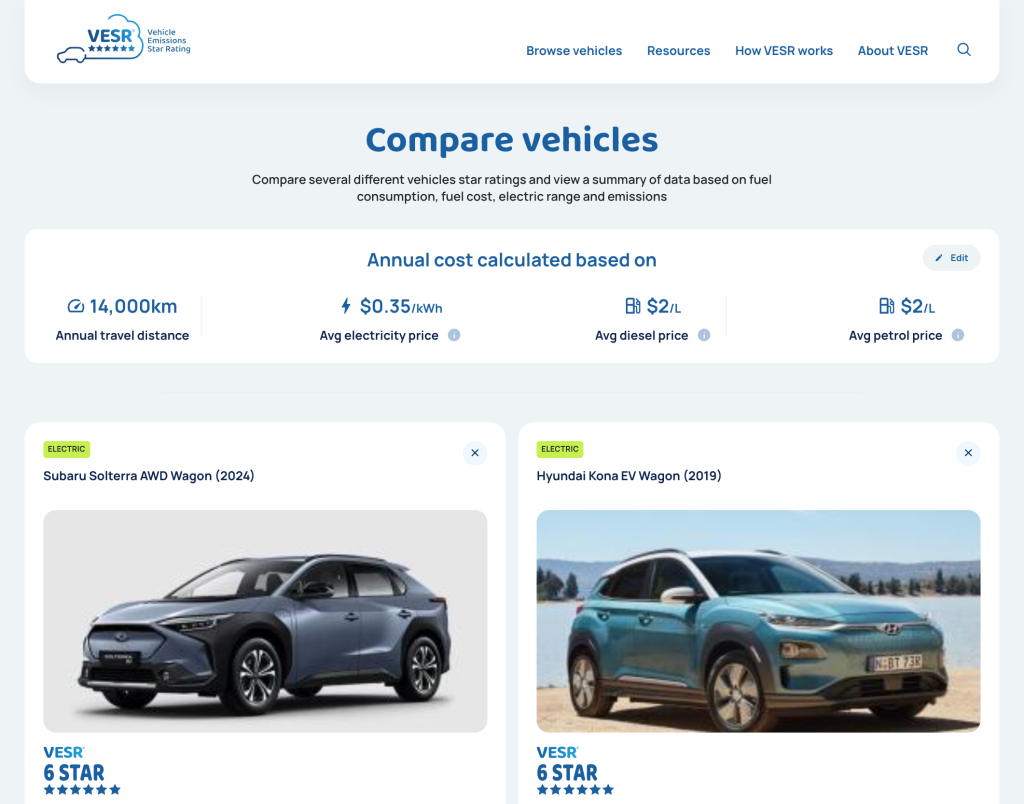The Vehicle Emissions Star Rating (VESR) website was initiated by the New South Wales Government and is administered by the Net Zero team. The Net Zero team is responsible for delivering on reducing emissions in the transport sector, which is part of the NSW Government’s plan to reach Net Zero by 2030.
VESR was launched in March 2024, in collaboration with the Commonwealth and endorsed by all Australian state and territory governments. Link Digital was one of a consortium of developers that worked on the project.

The VESR website has been designed to assist Australian consumers to factor in the environmental impact when planning their next vehicle purchase. It does this by using a simple star rating enabling them to compare the carbon dioxide (CO2) tailpipe emissions of over 16,000 passenger vehicles since 2004 that are 3.5 tonnes or less across petrol, diesel, hybrid, plug-in hybrid and fully electric engine types.
Manufacturers are legally required to provide the Commonwealth Government with emission and fuel consumption data for any vehicle sold in Australia. This information, based on laboratory tests that comply with specific Australian design rules, includes a standard test that measures the amount of CO2 released from a tailpipe per kilometre driven. This information is made available in the Australian Government’s Green Vehicle Guide. Information on fuel efficiency and CO2 emissions is also provided via a government mandated fuel consumption label that is applied to all vehicles sold in Australia.
What the VESR website does, that the Green Vehicle Guide and fuel consumption labels do not, is enable consumers to have a simple star rating, to view and compare the environmental impact of up to four vehicles at the same time. The Green Vehicle Guide also lacks the ability for people to view vehicle images, which can make it difficult if a consumer does not know what vehicle they are looking for.
The VESR website makes this existing information more accessible and easier to understand by utilising a straightforward star rating, like that used for some time now to measure the environmental impact of household appliances. All vehicles are rated up to six stars, in half star increments, based on the vehicle’s tailpipe emissions, with six stars representing no tailpipe emissions.
The website also enables users to add their estimated kilometres of travel and cost of petrol, diesel and/or electricity, to calculate an estimated yearly average fuel cost for their vehicle. The results in VESR show that the higher the star rating, the lower the annual fuel cost which reflects a more efficient vehicle.
Link Digital was one of several vendors involved in the creation of the VESR website.
We did the development build using Drupal, an open source content management system for making websites and web applications. This enabled us to present all the data in a simple, easy to use, and visually appealing format. The build was based on a design template for the site and the star rating done by another vendor, mov3ment, which we configured to enable the data to appear for each vehicle. This involved harvesting data not only from the Green Vehicle Guide, but a vehicle database known as GLASS, which provided the vehicle images, to make VESR much more user friendly. The Application Programming Interface is used to pull data from both data points, including regularly scheduled updates in terms of new vehicles, etc.
According to the Commonwealth Scientific and Industrial Research Organisation, transport is Australia’s third largest source of CO2 emissions, of which light vehicles are a major contributor.[i] The VESR system is a great example of data being used to enable consumers to measure vehicular tailpipe emissions and factor this into their purchase plans. This will, hopefully, deliver tangible results by helping drive down light vehicle emissions.
As well as calculating vehicle tailpipes CO2 emissions, the VESR website enables consumers to calculate the annual running cost of both petrol and electric vehicles, based on fuel price, model and annual travel distance. The site contains information developed by the Net Zero team, in consultation with experts, on issues such as understanding vehicle emissions, and the life cycle of emissions and how to reduce them. It also provides useful information for drivers of electric vehicles, such as locations of battery charging infrastructure and battery recycling.

The VESR website was only launched in March 2024, and the Net Zero team is planning on undertaking an awareness campaign to help more consumers understand how the site can be of value and to further encourage its use. The team are monitoring movements in Australia’s light car market with a view to keeping the site constantly updated. There are also plans to update the site with other vehicle types, such as LPG, given user feedback that has been received to date.
The Australian Automobile Association, the peak association for Australian motoring clubs, is currently undertaking a testing program of approximately two hundred vehicles, to identify how real world driving conditions compare to the lab tested results that inform the Green Vehicle Guide. According to Suzana Barbir, Net Zero team Program Officer, in a presentation to a Link Digital Public Forum in April 2024, they are monitoring these results with a view to seeing how they might be incorporated in a future iteration of the site.
Do you have a data project that you need assistance with?
Link Digital is ready to start a dialogue with you and your team on your open data needs. Contact us and tell us about your project.
[i] Commonwealth Scientific and Industrial research Organisation, Pathways to Net Zero Emissions – An Australian Perspective on Rapid Decarbonisation, November 2023, https://research.csiro.au/ieem/pathways-to-net-zero-emissions/